Computer Virus as an Animal? From linguistic to
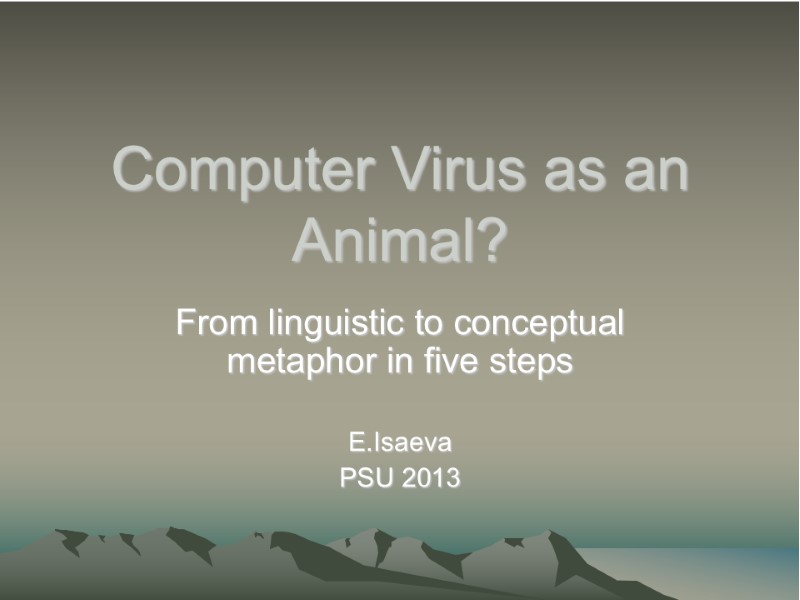
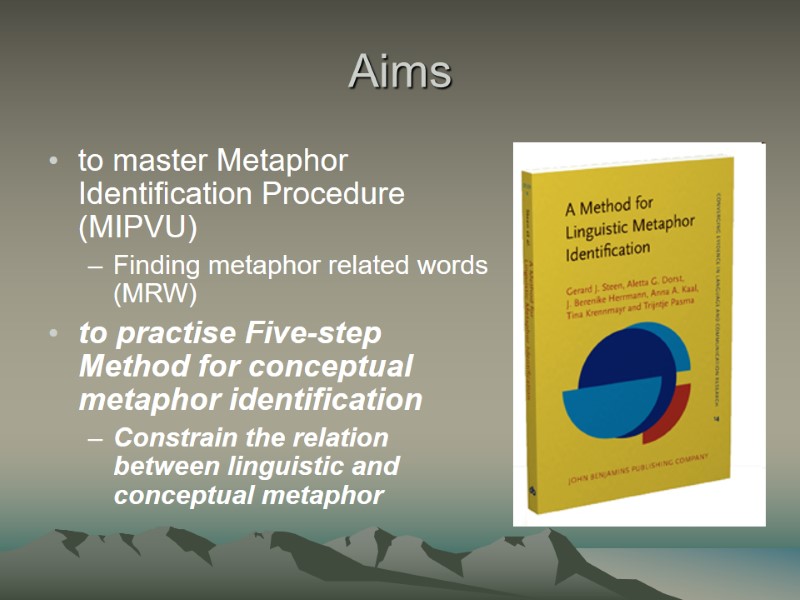
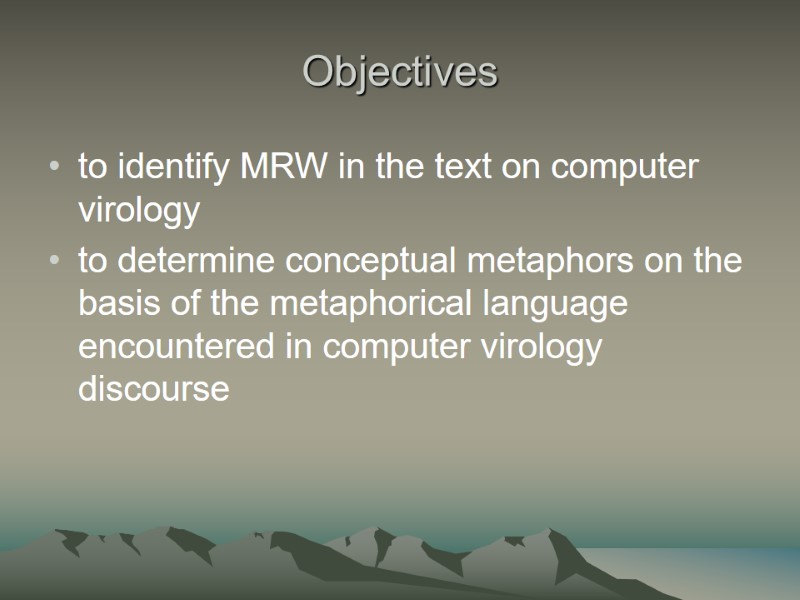
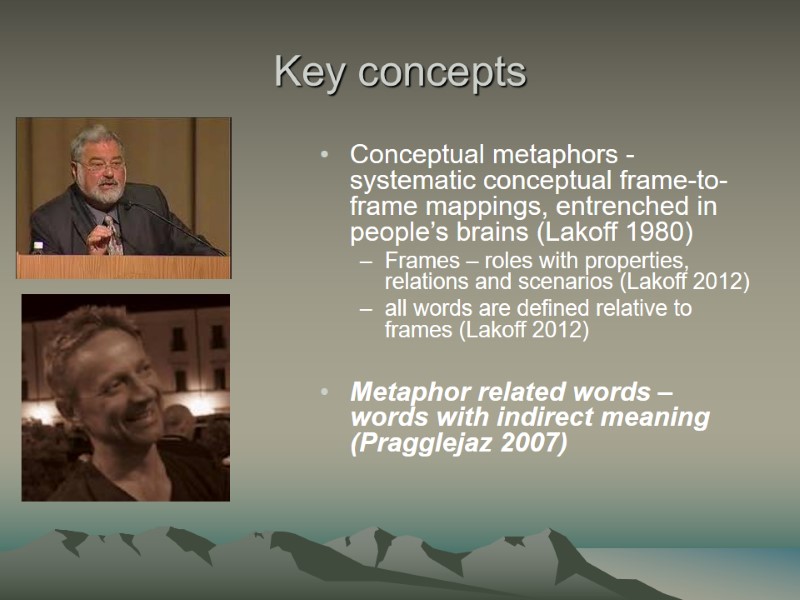
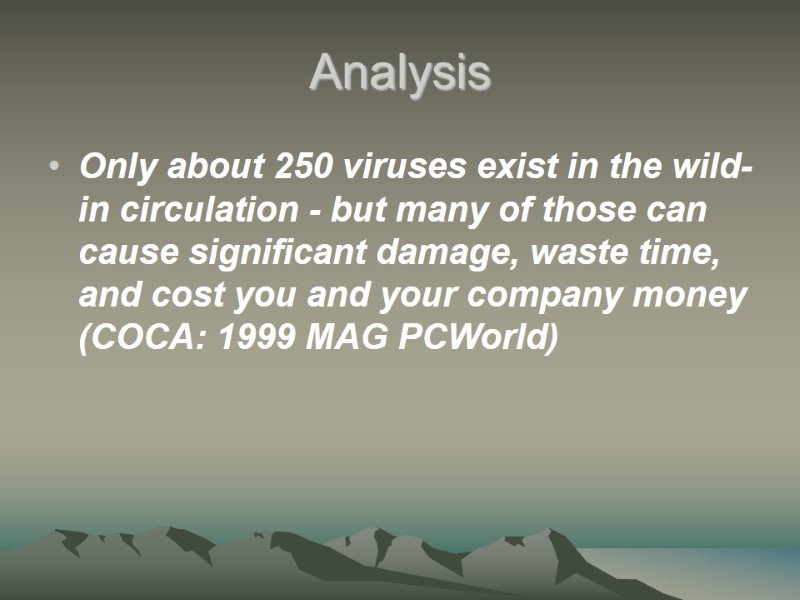
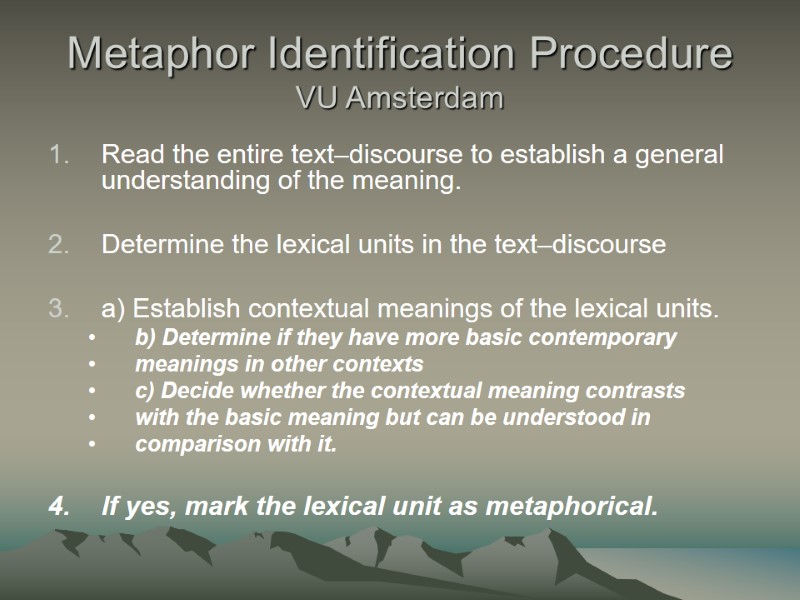
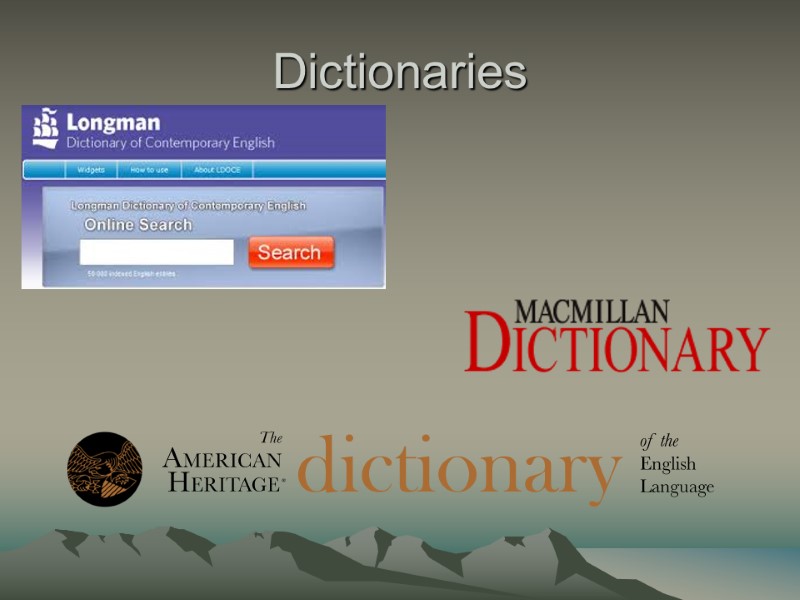
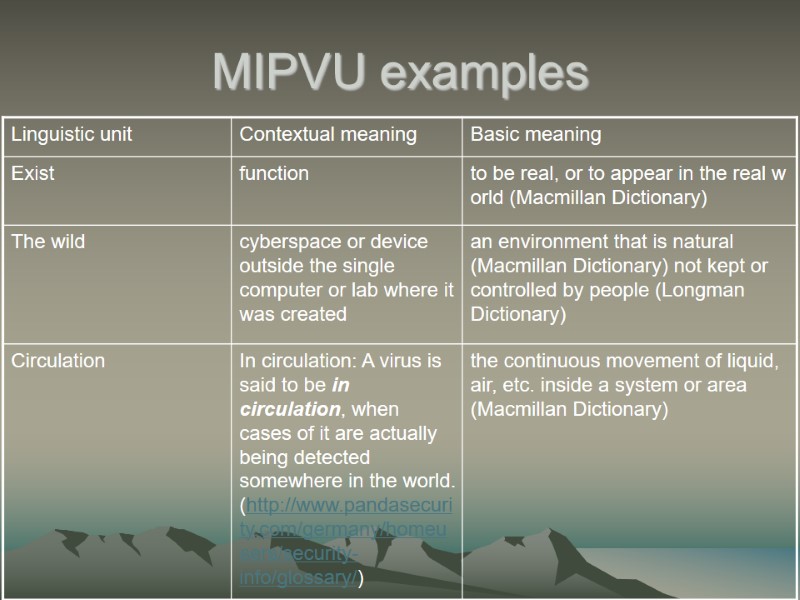
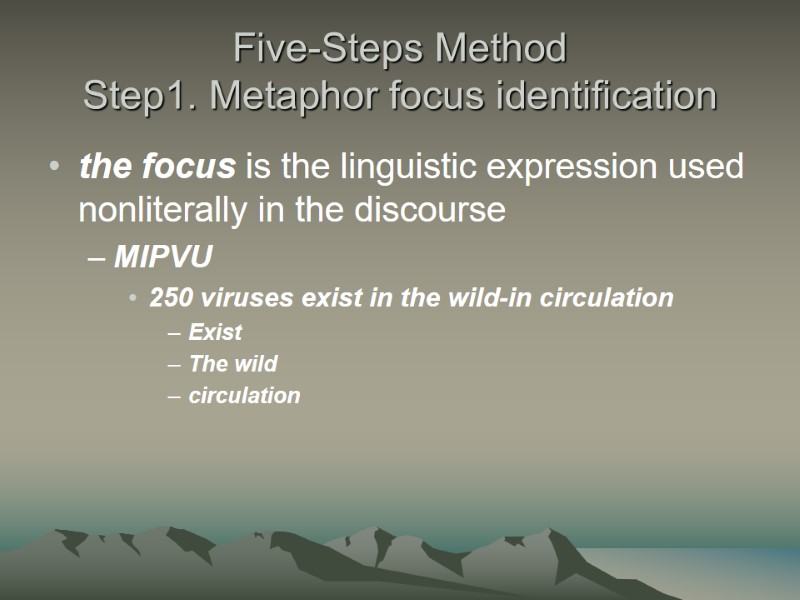
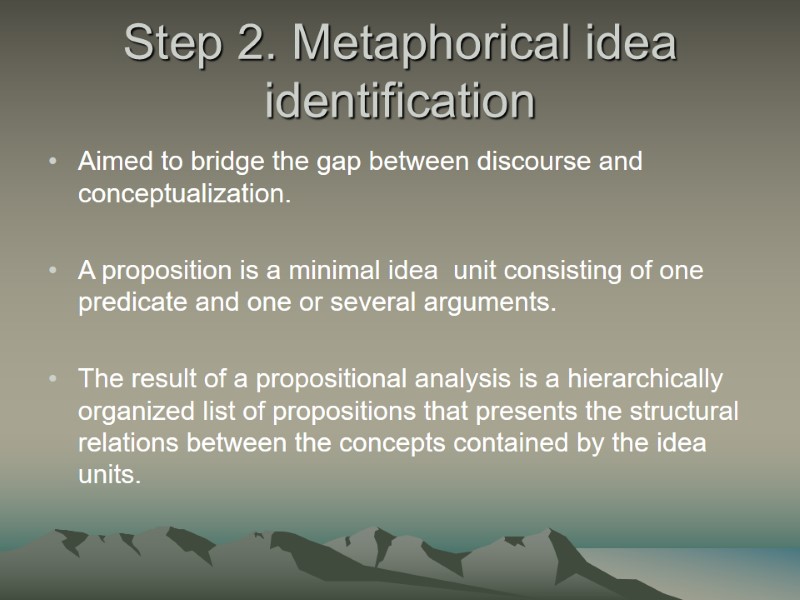
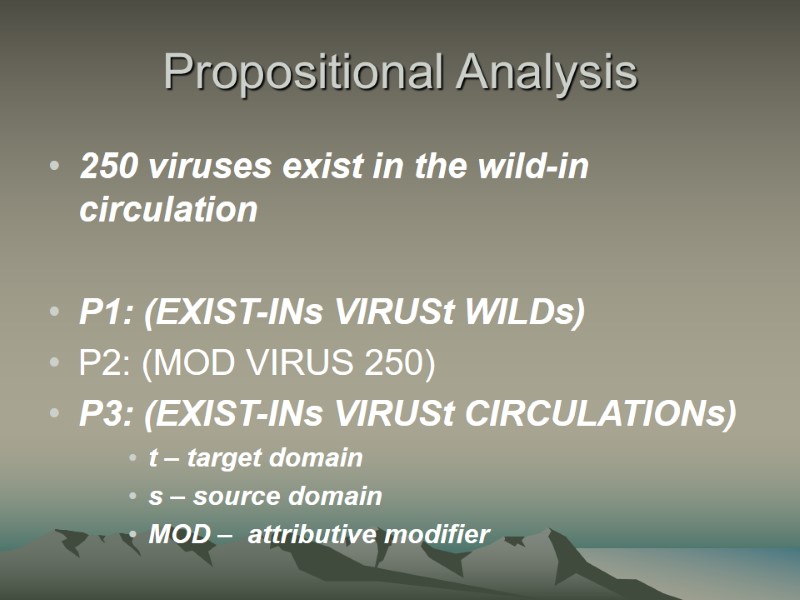
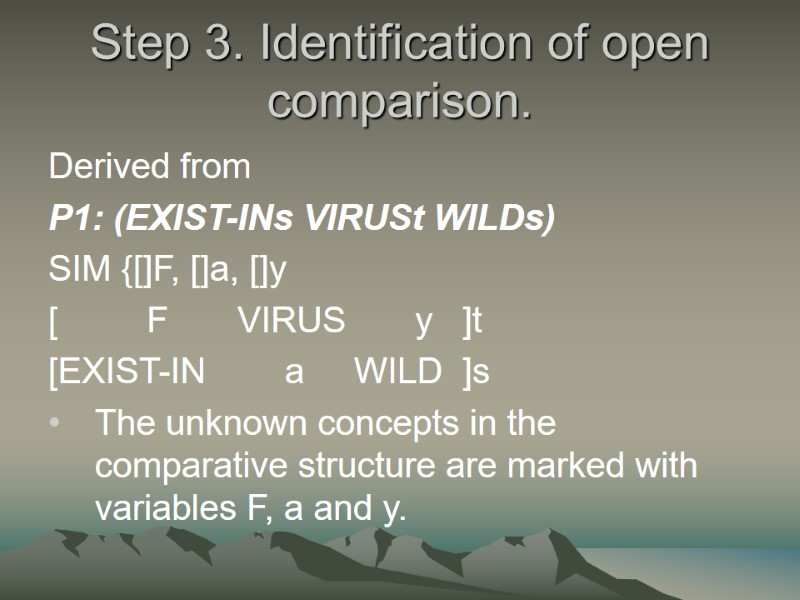
![Step 3. Identification of open comparison. Derived from P3: (EXIST-INs VIRUSt CIRCULATIONs) SIM{[]F,[]a, Step 3. Identification of open comparison. Derived from P3: (EXIST-INs VIRUSt CIRCULATIONs) SIM{[]F,[]a,](https://present5.com/presentacii-2/20171208\19844-virus_animal_5_steps.ppt\19844-virus_animal_5_steps_13.jpg)
![Step 4 Identification of Nonliteral analogy SIM{[]F,[]a, []y [FUNCTION-IN VIRUS CYBERSPACE-OUTSIDE-A-SINGLE-COMPUTER]t Step 4 Identification of Nonliteral analogy SIM{[]F,[]a, []y [FUNCTION-IN VIRUS CYBERSPACE-OUTSIDE-A-SINGLE-COMPUTER]t](https://present5.com/presentacii-2/20171208\19844-virus_animal_5_steps.ppt\19844-virus_animal_5_steps_14.jpg)
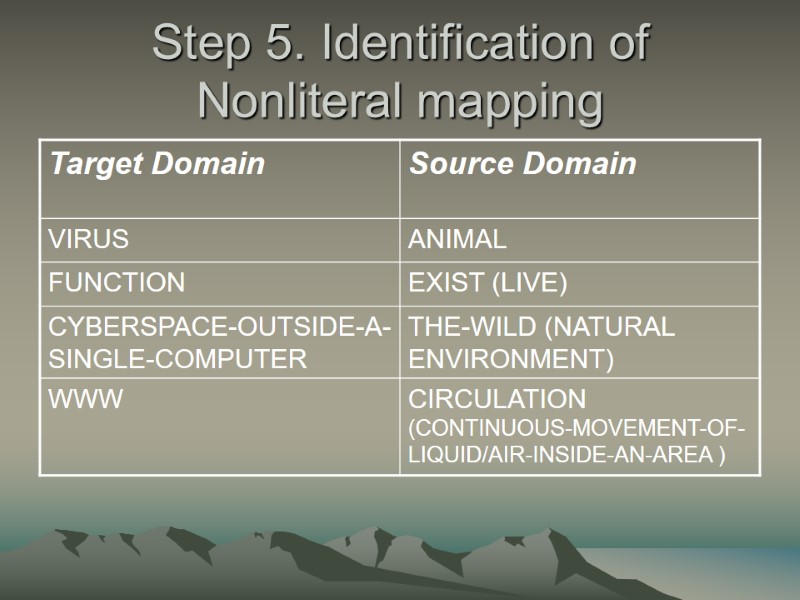
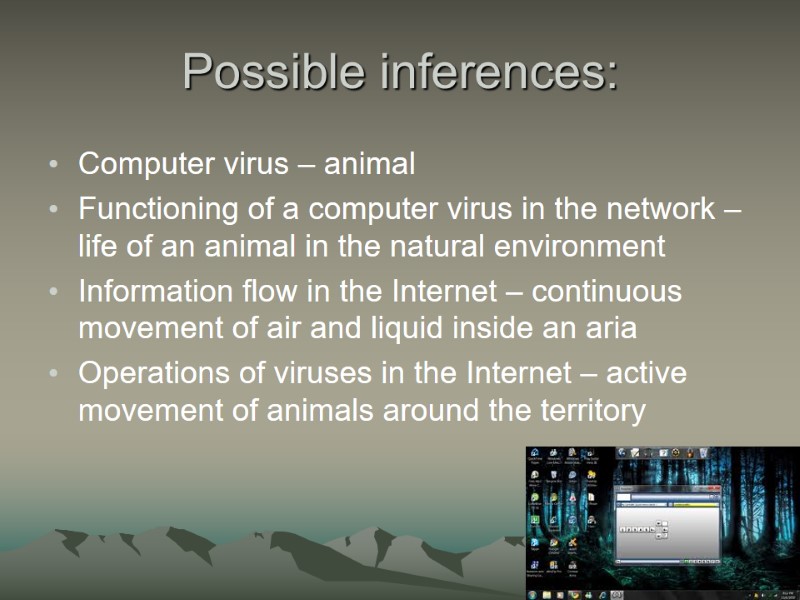
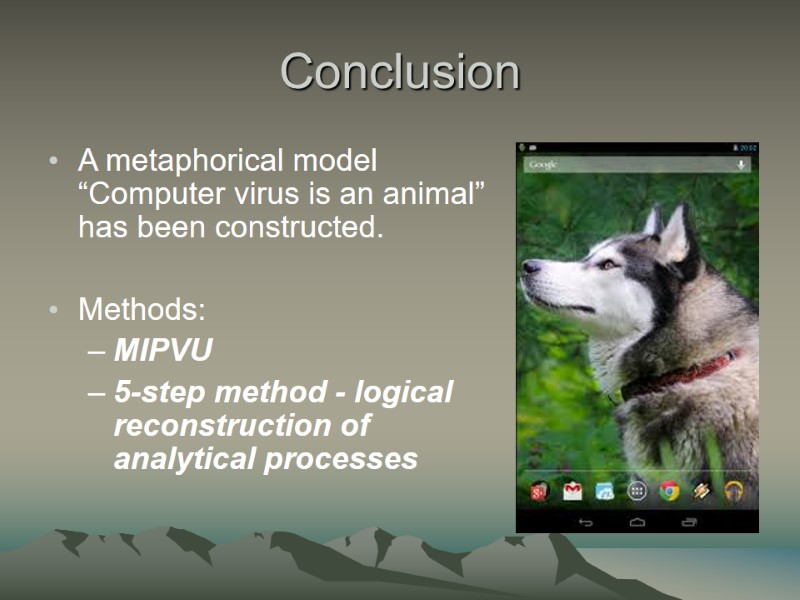

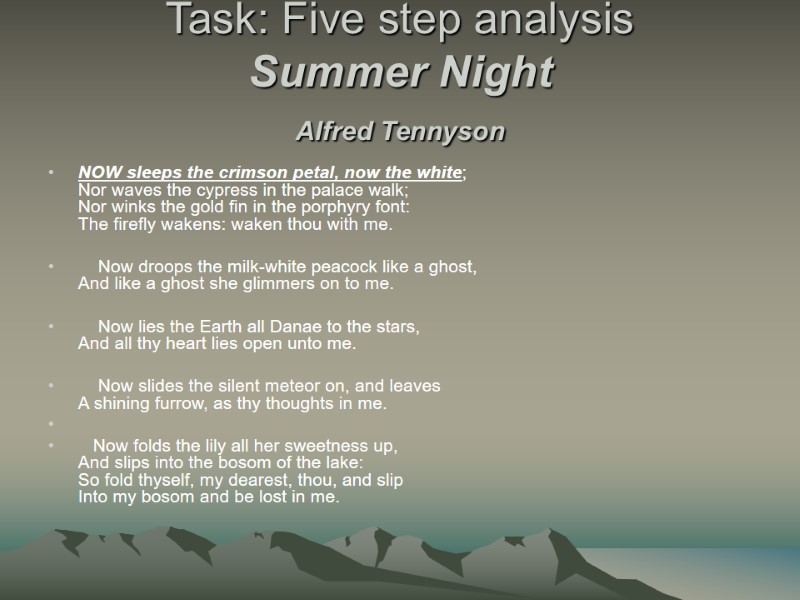
19844-virus_animal_5_steps.ppt
- Количество слайдов: 19
 Computer Virus as an Animal? From linguistic to conceptual metaphor in five steps E.Isaeva PSU 2013
Computer Virus as an Animal? From linguistic to conceptual metaphor in five steps E.Isaeva PSU 2013
 Aims to master Metaphor Identification Procedure (MIPVU) Finding metaphor related words (MRW) to practise Five-step Method for conceptual metaphor identification Constrain the relation between linguistic and conceptual metaphor
Aims to master Metaphor Identification Procedure (MIPVU) Finding metaphor related words (MRW) to practise Five-step Method for conceptual metaphor identification Constrain the relation between linguistic and conceptual metaphor
 Objectives to identify MRW in the text on computer virology to determine conceptual metaphors on the basis of the metaphorical language encountered in computer virology discourse
Objectives to identify MRW in the text on computer virology to determine conceptual metaphors on the basis of the metaphorical language encountered in computer virology discourse
 Key concepts Conceptual metaphors - systematic conceptual frame-to-frame mappings, entrenched in people’s brains (Lakoff 1980) Frames – roles with properties, relations and scenarios (Lakoff 2012) all words are defined relative to frames (Lakoff 2012) Metaphor related words – words with indirect meaning (Pragglejaz 2007)
Key concepts Conceptual metaphors - systematic conceptual frame-to-frame mappings, entrenched in people’s brains (Lakoff 1980) Frames – roles with properties, relations and scenarios (Lakoff 2012) all words are defined relative to frames (Lakoff 2012) Metaphor related words – words with indirect meaning (Pragglejaz 2007)
 Analysis Only about 250 viruses exist in the wild-in circulation - but many of those can cause significant damage, waste time, and cost you and your company money (COCA: 1999 MAG PCWorld)
Analysis Only about 250 viruses exist in the wild-in circulation - but many of those can cause significant damage, waste time, and cost you and your company money (COCA: 1999 MAG PCWorld)
 Metaphor Identification Procedure VU Amsterdam Read the entire text–discourse to establish a general understanding of the meaning. Determine the lexical units in the text–discourse a) Establish contextual meanings of the lexical units. b) Determine if they have more basic contemporary meanings in other contexts c) Decide whether the contextual meaning contrasts with the basic meaning but can be understood in comparison with it. If yes, mark the lexical unit as metaphorical.
Metaphor Identification Procedure VU Amsterdam Read the entire text–discourse to establish a general understanding of the meaning. Determine the lexical units in the text–discourse a) Establish contextual meanings of the lexical units. b) Determine if they have more basic contemporary meanings in other contexts c) Decide whether the contextual meaning contrasts with the basic meaning but can be understood in comparison with it. If yes, mark the lexical unit as metaphorical.
 Dictionaries
Dictionaries
 MIPVU examples
MIPVU examples
 Five-Steps Method Step1. Metaphor focus identification the focus is the linguistic expression used nonliterally in the discourse MIPVU 250 viruses exist in the wild-in circulation Exist The wild circulation
Five-Steps Method Step1. Metaphor focus identification the focus is the linguistic expression used nonliterally in the discourse MIPVU 250 viruses exist in the wild-in circulation Exist The wild circulation
 Step 2. Metaphorical idea identification Aimed to bridge the gap between discourse and conceptualization. A proposition is a minimal idea unit consisting of one predicate and one or several arguments. The result of a propositional analysis is a hierarchically organized list of propositions that presents the structural relations between the concepts contained by the idea units.
Step 2. Metaphorical idea identification Aimed to bridge the gap between discourse and conceptualization. A proposition is a minimal idea unit consisting of one predicate and one or several arguments. The result of a propositional analysis is a hierarchically organized list of propositions that presents the structural relations between the concepts contained by the idea units.
 Propositional Analysis 250 viruses exist in the wild-in circulation P1: (EXIST-INs VIRUSt WILDs) P2: (MOD VIRUS 250) P3: (EXIST-INs VIRUSt CIRCULATIONs) t – target domain s – source domain MOD – attributive modifier
Propositional Analysis 250 viruses exist in the wild-in circulation P1: (EXIST-INs VIRUSt WILDs) P2: (MOD VIRUS 250) P3: (EXIST-INs VIRUSt CIRCULATIONs) t – target domain s – source domain MOD – attributive modifier
 Step 3. Identification of open comparison. Derived from P1: (EXIST-INs VIRUSt WILDs) SIM {[]F, []a, []y [ F VIRUS y ]t [EXIST-IN a WILD ]s The unknown concepts in the comparative structure are marked with variables F, a and y.
Step 3. Identification of open comparison. Derived from P1: (EXIST-INs VIRUSt WILDs) SIM {[]F, []a, []y [ F VIRUS y ]t [EXIST-IN a WILD ]s The unknown concepts in the comparative structure are marked with variables F, a and y.
![>Step 3. Identification of open comparison. Derived from P3: (EXIST-INs VIRUSt CIRCULATIONs) SIM{[]F,[]a, >Step 3. Identification of open comparison. Derived from P3: (EXIST-INs VIRUSt CIRCULATIONs) SIM{[]F,[]a,](https://present5.com/presentacii-2/20171208\19844-virus_animal_5_steps.ppt\19844-virus_animal_5_steps_13.jpg) Step 3. Identification of open comparison. Derived from P3: (EXIST-INs VIRUSt CIRCULATIONs) SIM{[]F,[]a, []y [ F VIRUS y ]t [EXIST-IN a CIRCULATIONs ]s The unknown concepts in the comparative structure are marked with variables F, a and y.
Step 3. Identification of open comparison. Derived from P3: (EXIST-INs VIRUSt CIRCULATIONs) SIM{[]F,[]a, []y [ F VIRUS y ]t [EXIST-IN a CIRCULATIONs ]s The unknown concepts in the comparative structure are marked with variables F, a and y.
![>Step 4 Identification of Nonliteral analogy SIM{[]F,[]a, []y [FUNCTION-IN VIRUS CYBERSPACE-OUTSIDE-A-SINGLE-COMPUTER]t >Step 4 Identification of Nonliteral analogy SIM{[]F,[]a, []y [FUNCTION-IN VIRUS CYBERSPACE-OUTSIDE-A-SINGLE-COMPUTER]t](https://present5.com/presentacii-2/20171208\19844-virus_animal_5_steps.ppt\19844-virus_animal_5_steps_14.jpg) Step 4 Identification of Nonliteral analogy SIM{[]F,[]a, []y [FUNCTION-IN VIRUS CYBERSPACE-OUTSIDE-A-SINGLE-COMPUTER]t [ EXIST-IN ANIMAL WILD ]s SIM{[]F,[]a, []y [ FUNCTION-IN VIRUS WWW ]t [ EXIST-IN ANIMAL CIRCULATION (CONTINUOUS-MOVEMENT- OF- LIQUID/AIR-INSIDE-AN-AREA)]s
Step 4 Identification of Nonliteral analogy SIM{[]F,[]a, []y [FUNCTION-IN VIRUS CYBERSPACE-OUTSIDE-A-SINGLE-COMPUTER]t [ EXIST-IN ANIMAL WILD ]s SIM{[]F,[]a, []y [ FUNCTION-IN VIRUS WWW ]t [ EXIST-IN ANIMAL CIRCULATION (CONTINUOUS-MOVEMENT- OF- LIQUID/AIR-INSIDE-AN-AREA)]s
 Step 5. Identification of Nonliteral mapping
Step 5. Identification of Nonliteral mapping
 Possible inferences: Computer virus – animal Functioning of a computer virus in the network – life of an animal in the natural environment Information flow in the Internet – continuous movement of air and liquid inside an aria Operations of viruses in the Internet – active movement of animals around the territory
Possible inferences: Computer virus – animal Functioning of a computer virus in the network – life of an animal in the natural environment Information flow in the Internet – continuous movement of air and liquid inside an aria Operations of viruses in the Internet – active movement of animals around the territory
 Conclusion A metaphorical model “Computer virus is an animal” has been constructed. Methods: MIPVU 5-step method - logical reconstruction of analytical processes
Conclusion A metaphorical model “Computer virus is an animal” has been constructed. Methods: MIPVU 5-step method - logical reconstruction of analytical processes
 Thank you for your attention
Thank you for your attention
 Task: Five step analysis Summer Night Alfred Tennyson NOW sleeps the crimson petal, now the white; Nor waves the cypress in the palace walk; Nor winks the gold fin in the porphyry font: The firefly wakens: waken thou with me. Now droops the milk-white peacock like a ghost, And like a ghost she glimmers on to me. Now lies the Earth all Danae to the stars, And all thy heart lies open unto me. Now slides the silent meteor on, and leaves A shining furrow, as thy thoughts in me. Now folds the lily all her sweetness up, And slips into the bosom of the lake: So fold thyself, my dearest, thou, and slip Into my bosom and be lost in me.
Task: Five step analysis Summer Night Alfred Tennyson NOW sleeps the crimson petal, now the white; Nor waves the cypress in the palace walk; Nor winks the gold fin in the porphyry font: The firefly wakens: waken thou with me. Now droops the milk-white peacock like a ghost, And like a ghost she glimmers on to me. Now lies the Earth all Danae to the stars, And all thy heart lies open unto me. Now slides the silent meteor on, and leaves A shining furrow, as thy thoughts in me. Now folds the lily all her sweetness up, And slips into the bosom of the lake: So fold thyself, my dearest, thou, and slip Into my bosom and be lost in me.
